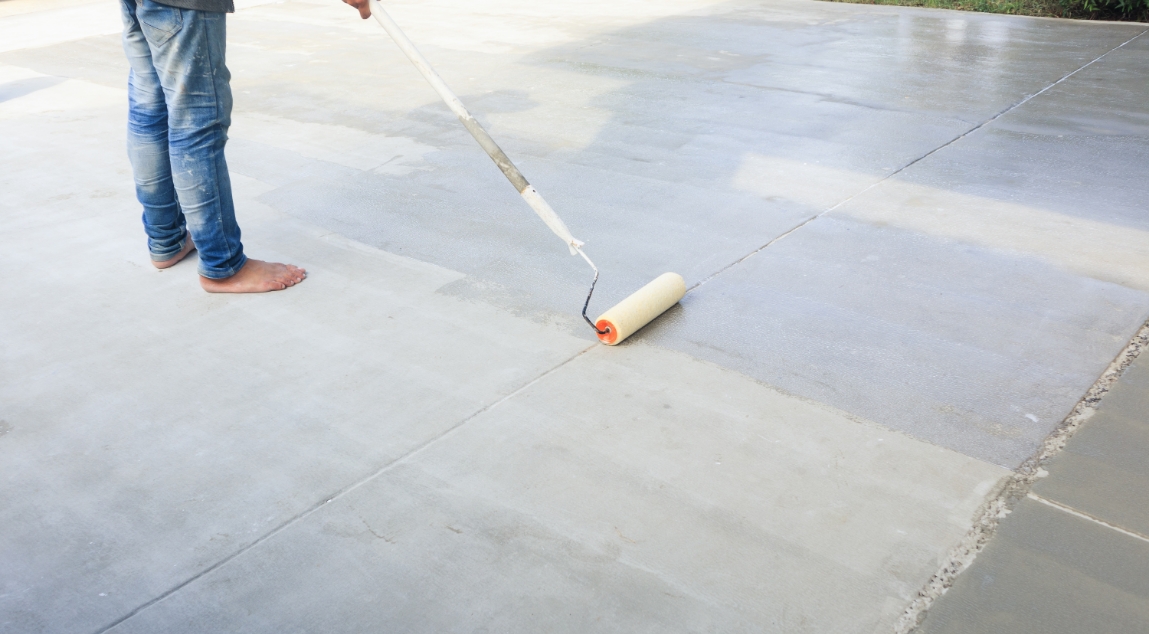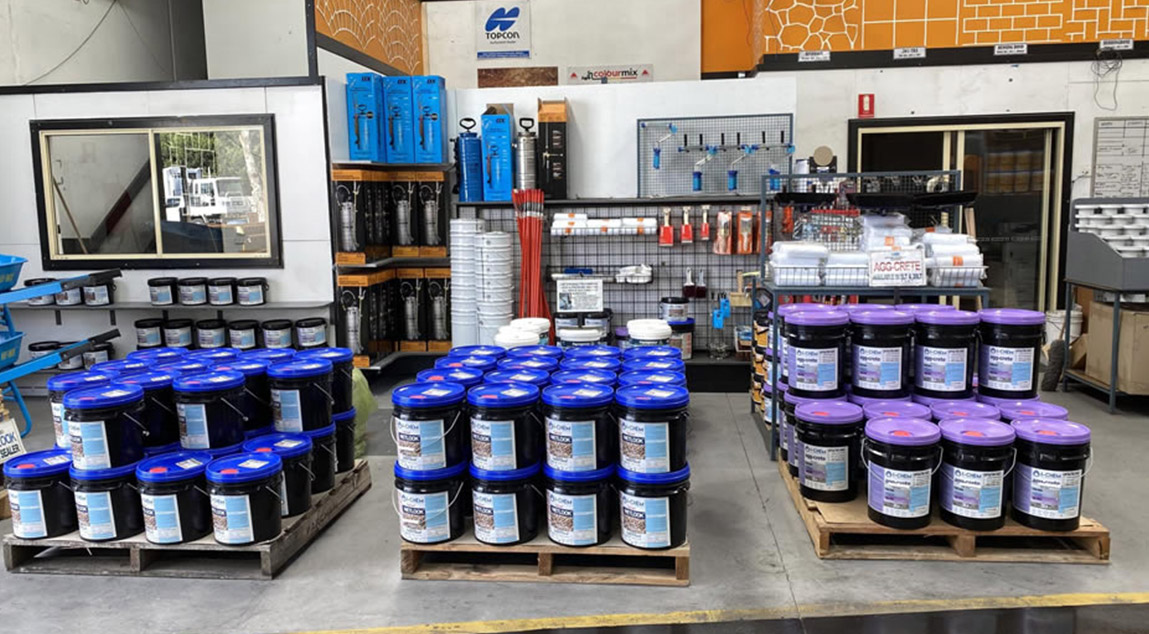Concrete Sealer Troubleshooting: Common Problems and Solutions

Concrete is a material widely used in construction due to its durability, versatility, and low price point. However, to maintain its quality and longevity, concrete requires proper sealing. This process, while seemingly straightforward, can present a number of challenges if the user is unfamiliar with the selection of suitable sealants and application techniques.
In this guide, we’ll provide a comprehensive look into common problems encountered during the sealing process and their corresponding solutions.
What Are Concrete Sealers?
Concrete sealers are a protective layer applied over a concrete surface to provide defence against water, oil, grease, and UV. Over time, these can cause degradation, leading to damage that ranges from superficial to structural. As a safeguard, adding a concrete sealer to your project is fundamental to keeping your concrete looking and functioning its best.
Concrete sealers come in a variety of types, each boasting a unique set of advantages and tailored uses. Some sealers are designed to enhance the aesthetic appeal of the concrete, providing a glossy finish that amplifies the natural textures and colours. Others take a more practical approach to focus on protection against environmental elements and physical wear and tear.
Beyond the obvious protective benefits, sealers can enhance the aesthetic appeal of concrete surfaces, creating a glossy and polished finish. They can also increase the concrete’s resistance to stains, making cleaning and maintenance a breeze.
However, it’s essential to be aware of the potential downsides. Improper application can lead to issues such as peeling, blistering, and discolouration. Let’s discuss some of the most common issues you may encounter and how to avoid or fix them.
Want to learn more about water-based and solvent-based concrete sealers? For a more in-depth look, read our guide here.
Blistering or Bubbling
It’s no secret that the integrity of a concrete sealer can be compromised by the formation of blisters and bubbles. Trapped air, moisture, or gas beneath the sealer is typically the culprit. This can occur when the concrete surface isn’t adequately prepared before the sealer’s application.
Prevention
To prevent this from happening, you must make sure that your concrete is completely dry and free of contaminants before you start. Also, be wary of hot or rainy weather, as applying sealer in high humidity or extremely hot conditions can also lead to bubbles and blisters. Make sure to leave at least two full days between the last rainfall and applying your sealer.
Repair
What if blisters or bubbles have already formed? Don’t worry, there are remedies available! The best solution is to knock the bubbles off the surface and then come in with an additional layer of sealer when the weather is cooler and dryer.
While this solution might seem straightforward, you need to consider a few things. First, ensure that the fresh sealer you’re using is compatible with the original sealer. Mixing different types of sealers can lead to peeling, so if possible, use the same sealer as the first coat.
Secondly, when popping the blisters, be gentle to avoid causing further damage to the concrete surface. Use a sharp tool, but be careful not to cause gouges in the surface.
Lastly, when refilling the popped blisters, apply the sealer in thin, even coats to prevent over-application, which could lead to dark, blotchy patches.
Efflorescence
Efflorescence, or white salt deposits, is a common issue that plagues sealed concrete surfaces. This unsightly reaction is caused by salty groundwater entering the concrete and then bringing the salt to the surface as it evaporates. The residual white or grey powdery substance not only detracts from the aesthetics of your concrete but it can also lead to degradation over time.
Prevention
Moisture is the main culprit. Therefore, a critical step in preventing these white salt deposits is ensuring proper drainage. Water accumulation under concrete can accelerate efflorescence, particularly in areas with heavy rainfall or insufficient slope for water runoff. Thus, it’s essential to design your concrete surfaces with proper sloping and drainage in mind. Additionally, consider implementing a French drain system if standing water is a recurring issue in your space.
Adding an extra coat or two of sealant to your concrete is also important to ensure the salt can’t come to the surface and accumulate on top.
Repair
Luckily for you, efflorescence is relatively easy to remove. If it’s not too extensive, a simple wash with water removes the salts. If there is more extensive salt residue, a weak acid solution can be scrubbed in and rinsed off. Once the efflorescence is removed, adding an extra layer of sealer will help to keep the salt buildup at bay.
Peeling or Flaking
Peeling is a common issue that may seem like a simple annoyance, but peeling can pose a significant setback to your project’s success, undermining the sealer’s protective function and the aesthetic appeal of your surface.
Prevention
The main culprits behind peeling and flaking are often poor surface preparation, excessive sealer application, or incompatible sealers.
Preparing the surface is a fundamental step in the sealing process. The surface must be clean and free from dust, dirt, oil, or any other contaminants that might prevent the sealer from adhering properly to the concrete. Moreover, the surface must be dry, as moisture can interfere with adhesion, leading to peeling.
When trying to achieve a smooth, glossy finish, it’s tempting to layer on the sealer, but this could lead to disastrous results. Over-application of the sealer can result in a thick, uneven layer that does not cure properly, leading to peeling. It’s advisable to apply thin, even coats, allowing each layer to dry completely before applying the next.
The choice of sealer also plays a pivotal role in whether your sealer stays put or starts to peel. Not all sealers are created equal, and not all of them are compatible with every type of concrete surface. Understanding the compatibility of your sealer with your concrete surface is crucial to prevent peeling.
If you’re looking for advice on water or solved based concrete sealers, we are here to help! Contact Australian Slate-Crete Supplies’ friendly team for advice today!
Repair
So, what if peeling has already occurred? Don’t panic. The solution involves stripping the peeling sealer, thoroughly cleaning and preparing the surface, and then reapplying a fresh coat of sealer. Yes, it’s labour-intensive, but remember, the longevity and quality of your concrete surface depend on it.
Understanding why sealers peel is half the battle won. Equipped with this knowledge, you can now take proactive steps to prevent peeling and ensure a successful concrete sealing project. As you proceed, always remember the golden rule: preparation is key. Take your time to prepare the surface, apply the sealer in thin, even layers, and choose a sealer that is compatible with your concrete surface. Happy sealing!
Dark or Blotchy Concrete
Darkened or blotchy concrete can be disheartening, particularly after investing time and effort into sealing. It’s crucial to understand that this is typically a result of over-application or uneven application of the sealer.
To give some context, sealers work by penetrating the concrete surface to form a protective layer. However, when applied excessively or unevenly, the sealer can settle in pools or thicker layers in certain areas. These over-saturated portions can lead to discolouration, often manifesting as darker or blotchy spots once the sealer dries.
Prevention
To prevent this issue, applying the sealer in thin, even coats is essential. This allows the sealer to penetrate the surface uniformly and dry consistently, preventing unwanted discolouration. Using a quality applicator, such as a sprayer or roller, and working in a methodical manner can significantly aid in achieving a uniform application.
Repair
What if your concrete is already dark or blotchy? While it might seem like a daunting task, the solution lies in stripping and resealing the concrete. This process involves removing the existing sealer, typically using a chemical stripper, and then reapplying the sealer. It’s essential to take extra care during the reapplication process, ensuring you apply thin, even coats to avoid running into the same issue again.
However, before you dive into stripping and resealing, it’s worth considering whether the dark or blotchy appearance could be due to other factors. For instance, moisture trapped beneath the sealer or efflorescence, which we’ve discussed in previous sections, can also cause discolouration. If these factors are at play, you may need to address these issues before proceeding with the stripping and resealing.
Knowledgeable Concrete Sealer Product Suppliers
Concrete sealing is a sometimes tricky process. It requires patience, attention to detail, and a solid understanding of the materials at hand. But, with the right knowledge, tools, and a healthy dose of determination, you can confidently undertake your DIY concrete sealing project and look forward to a long-lasting, aesthetically pleasing result.
For friendly and industry-leading advice, contact Australian Slate-Crete Supplies. We sell everything you’ll need to lay down, maintain or repair sealer. We also provide advice backed by 25 years in the concreting business. For a chat with our staff about your next project, contact us today on 03 9408 7722.
-
 February 4, 2022Sandstone Concrete Stencil
February 4, 2022Sandstone Concrete StencilDo you want to add a touch of luxury and elegance to your concrete projects? If so, then consider using sandstone concrete stencils!
Read More -
 February 4, 2022Gloss Brick Sealer
February 4, 2022Gloss Brick SealerGloss brick sealer is a wonderful material for adding a brilliant shine to your brick slip wall feature.
Read More -
 February 4, 2022Bluestone Concrete Sealer
February 4, 2022Bluestone Concrete SealerIn a broad sense, the term “bluestone” is sometimes used to refer to a variety of stones. It’s a marketing term rather than a geological one.
Read More
